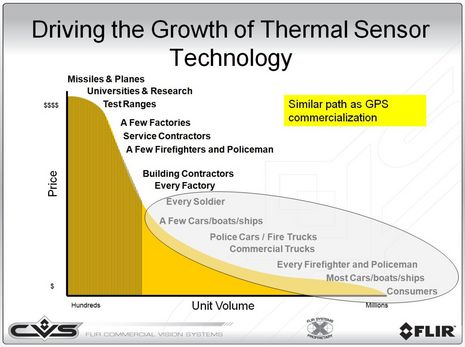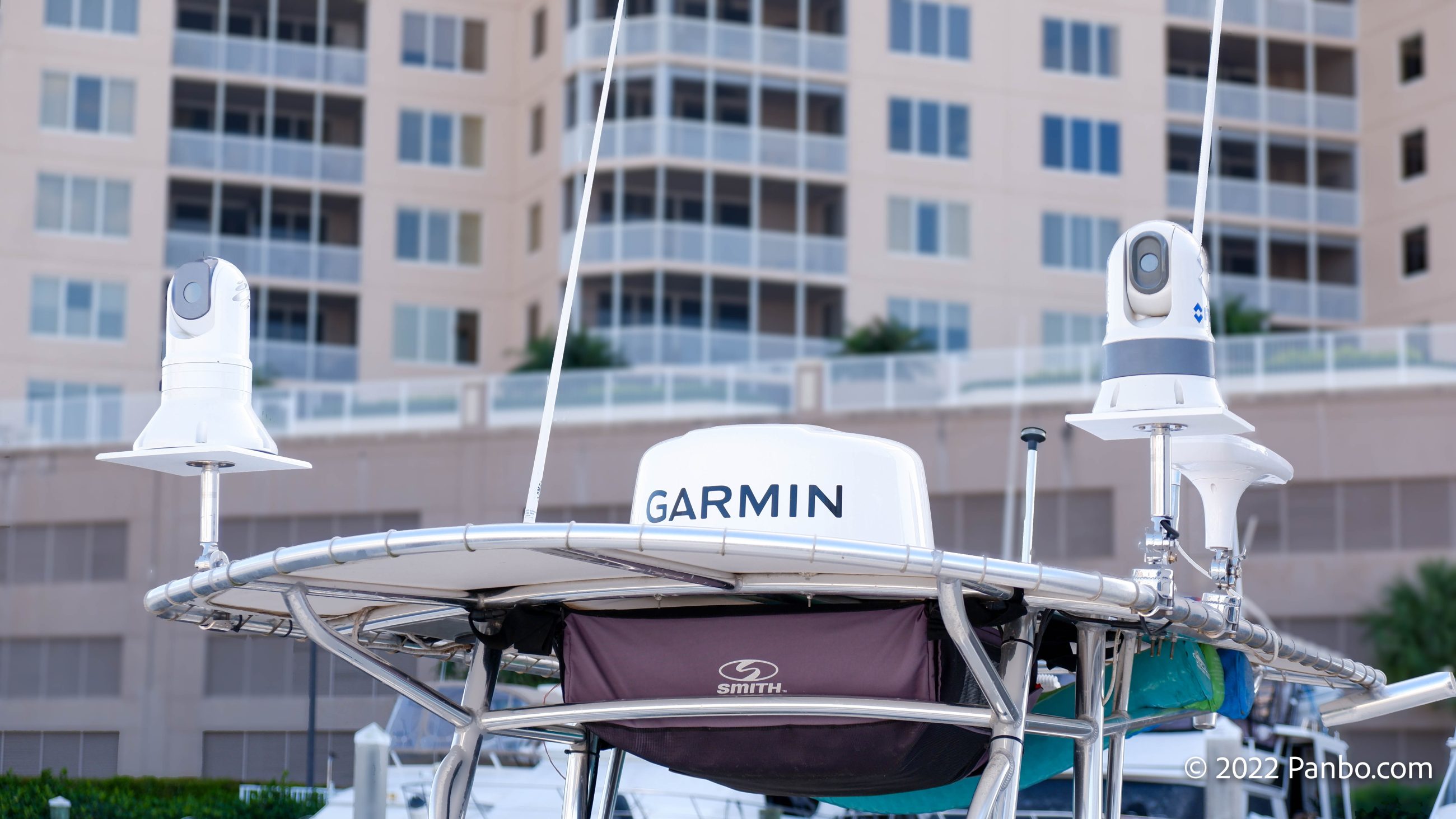Thermal imaging, coming to your boat eventually?
This graph is a thermal sensor manufacturer’s dream — and was, in fact, created by the marketing department at FLIR — but, hey, that’s us way over to the right. I’d love to see the price of thermal cameras go so low, and unit volume so high, that “most cars/boats/ships” have them. Like GPS, once you understand how well the technology works, you want to have it aboard. I remember well the Magellan Nav 1000 (below), which seemed totally magic 20 years ago, but was actually quite crude and cost over $1,000…
Actually, thermal cameras are at least part way along that seductive price/adoption rate curve, largely driven by FLIR, which seems to dominate most aspects of the technology. Consider this little-known factoid about the recent Maersk Alabama vs Somali pirates saga: FLIR thermal sensors were in use on the USS Bainbridge (the Navy vessel that rescued the Captain), and on the drones flying overhead, and on the sniper rifles. I learned this because a FLIR representative recently visited Camden, and even set up the new high res M626L on a hotel balcony. It’s amazing how much more detail and range you get from 640×480 pixels than you do from 320×240, which is the norm for less-than-mega yacht thermal cams. The M-Series is what I’d like to install on Gizmo’s masthead, and use to learn what seeing with temperature, instead of light, really means. I think FLIR is going to let me do that, which is great, but, at $20,000, the M646L is four times the cost of FLIR’s entry level Navigator, and equates to the entire cost of a pretty good dual helm MFD system with radar, sonar, and a decent selection of NMEA 2000 sensors.
I do get a kick out of this image I found of what was arguably the first handheld GPS. I recall trying one on a delivery when Magellan first brought them out and, though “intuitive” did not apply, falling into a state of deep techno lust. Thermal imaging has already evolved to be a lot easier to use, but let’s hope it follows this “white brick” down a steep cost/unit incline.















YIKES,
I was an early adapter of GPS and purchased a Trimble NavTrac GPS for something like $6,000. While it did work and was pretty basic and plotted a track on a lat lon grid (scalable) it’s nothing compared to what you can get for 1/10th of the price today.
I don’t buy the story that they have to charge a lot at first to recover their R&D costs. I’d rather think that if they have something hot they flood the market with it at the real price point and get the market excited and adapting it.
The NASA AIS class C was like that – cheap and got me into it and now I wait for the next level to come down in price.
Patience is a virtue.
Likewise, SanderO. I had a Trimble TANS in my BEHEMOTH bicycle in 1990… frightfully expensive device (fortunately, sponsored) that added hugely to my high-tech couch-circuit management system while bicycle touring, and also let me location-stamp outgoing email. Ah (*creak*) the good old days.
My first “consumer” GPS was the Motorola Traxar, which I used on the first Microship version during a 1993 gonzo adventure in the Pacific Northwest. It was startling to realize, pedal-sailing one-person micro-trimarans during an all-nighter in the fog, that without that tech we would have been bobbing around in the shipping lanes, trying to do DR in unfamiliar waters with interesting currents.
We sure do take these things for granted now. But I have a sextant aboard anyway, given the unknowns of salt water, lightning, EMP, and the winds of political change. Dependency on things that can be shut off (or go fizzle) makes me much more nervous than it used to.
Still, I’m lusting after FLIR. Played with it in a showroom once; you could see the tracks left by passing humans on the carpet, the heat of underarms, the warmth of a laptop. Much better than night vision. Want. Want.
Steve
I don’t care how its done, I just want to avoid crab trap floats at night. Its shear misery trying to untangle someone’s livelihood from my props while drifting into the mud on my way back from a long day of sailing.
FLIR is clearly outside my budget, but I’m not convinced that there is nothing else that will do the job.
I’m not sure it will be the next Ipod, but someone is going to get my pittance when they come up with the poor man’s version!
I am nearing installing my third FLIR system. I have used the Navigator and it is really a boon to night driving. The most eye opening experience was the first time I used it during a 4th of July fireworks show. The harbor had hundreds of boats in a small area. Looking down a channel all you could see was navigation lights. However, even then many did not have any lights on (the kayaks especially), some had anchor lights (even when not at anchor) and others were just a dense bundle of various colored lights. When you turn the FLIR on you see each boat in detail! This includes the kayaks sitting low in the water.
It really is a great item to have if you do a lot of night travel.
I am headed to Santa Barbara next week for a special class put on by FLIR and am looking at adding the M-series before a trip to Mexico this Fall.
Ultimately these items should become more prevalent.
I have one of those white bricks – need one for your museum?
The FLIR units are great. Our local marine patrol has one of the big water cooled eyeball types that as I recall was something north of $100k? Yeah, they need to work on the price of these things.